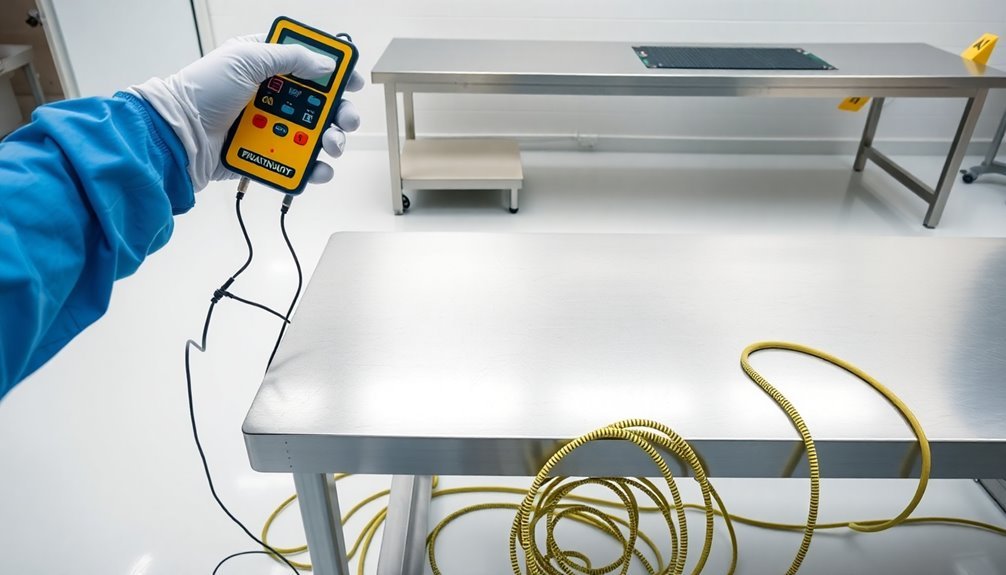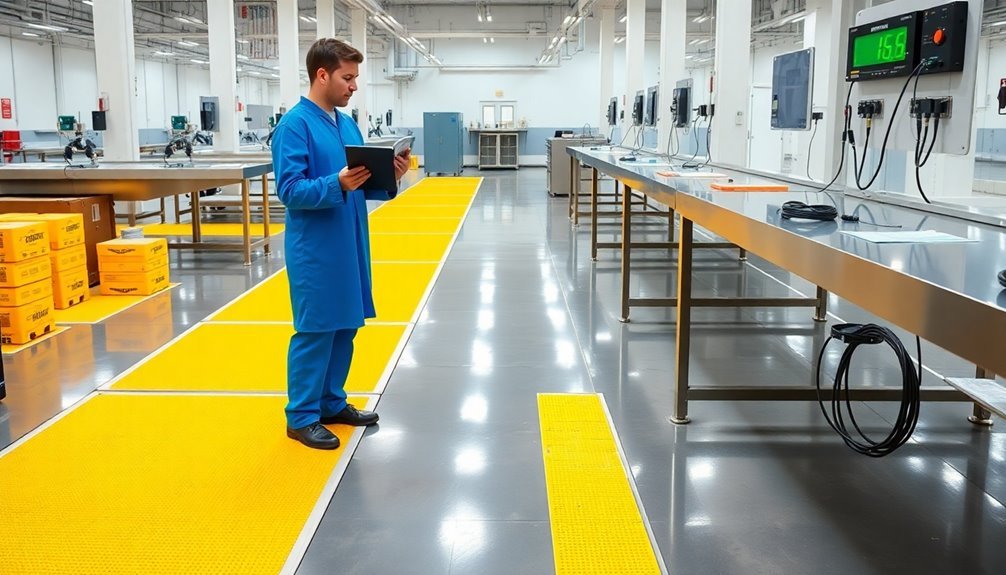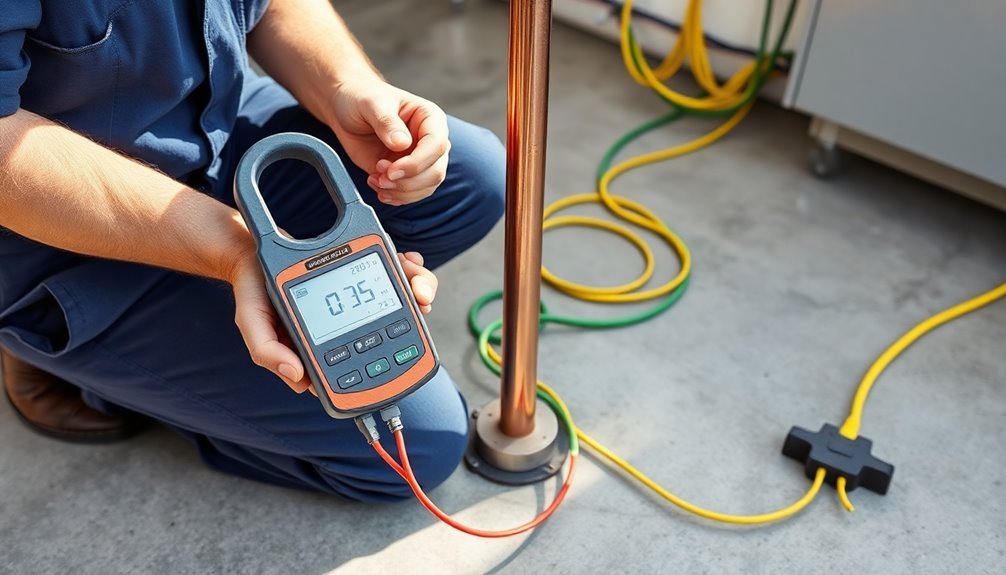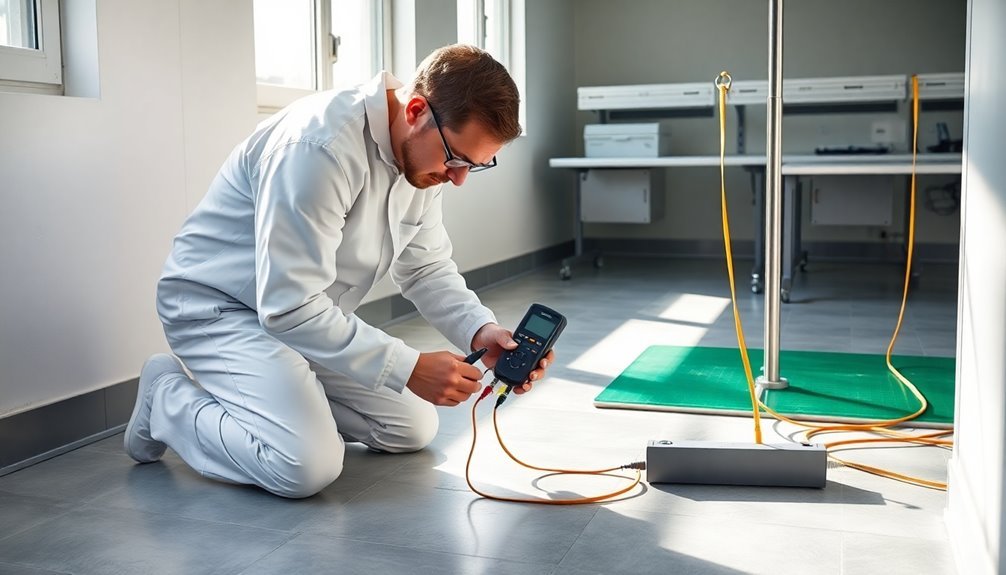Seven essential tips for evaluating your anti-static facility: First, confirm all testing equipment meets ANSI/ESD standards and maintains proper calibration. Second, implement thorough environmental monitoring for humidity (35-60%) and temperature control. Third, verify personnel training records and competency assessments are current. Fourth, conduct regular ESD floor resistance measurements with walking body voltage tests. Fifth, perform systematic grounding integrity checks maintaining resistance below 10Ω. Sixth, inspect all PPE including smocks, gloves, and wrist straps for effectiveness. Seventh, document and review workspace maintenance protocols. These fundamentals form just the foundation of a robust anti-static program.
Testing Equipment and Calibration Requirements

To guarantee reliable anti-static facility operations, you'll need properly calibrated testing equipment that meets stringent industry standards. Your testing arsenal should include equipment that complies with ANSI/ESD STM7.1 for floor material testing and ANSI/ESD STM97.1 for measuring system resistance with static control footwear. Maintaining relative humidity levels between 35% and 60% in your testing environment helps ensure accurate measurements.
You'll need to maintain your ESD guns with regular calibration, comparing their outputs against known reference values. Don't skip these calibrations – they're essential for accuracy and preventing unexpected maintenance issues.
Make certain you're following the manufacturer's recommended calibration intervals and keeping detailed records of all certifications.
Your facility's grounding equipment must maintain resistance below 10Ω, while floor materials should test at less than 1.0 x 10E9 ohms for point-to-point and point-to-ground measurements.
You'll want to install anti-static workbenches equipped with desk pads, wrist strap connectors, and proper ground wire connections. Remember to regularly test these components to verify they're functioning correctly.
Keep your calibration certificates current and traceable to national standards. This documentation isn't just paperwork – it's your proof of compliance and helps maintain your ESD Control Program's integrity.
Environmental Monitoring Documentation Guidelines
You'll need to consistently track and document humidity levels throughout your anti-static facility using calibrated sensors and automated data logging systems.
Environmental monitoring must include systematic sampling techniques to ensure comprehensive assessment of static-sensitive areas.
Your temperature control documentation should include real-time monitoring data, acceptable ranges, and any deviations that could affect static-sensitive operations.
Maintaining detailed records of both humidity and temperature trends will help you identify patterns, anticipate potential issues, and demonstrate regulatory compliance for your anti-static environment.
Humidity Tracking Best Practices
In accordance with industry standards, establishing proper humidity tracking protocols requires an elaborate environmental monitoring program supported by detailed documentation guidelines.
You'll need to select appropriate monitoring instruments based on your facility's specific needs – from simple humidity indicator strips for basic readings to sophisticated data loggers for precise measurements.
Position your sensors strategically throughout the facility, verifying they're above floor level and away from direct air vents, doors, and windows. Consistent cool conditions help prevent deterioration of sensitive materials and equipment.
In data centers, you'll want to place sensors near air intake vents at the front of rack-mount chassis and install multiple sensors per rack for thorough monitoring.
Make sure you're documenting all sampling results and maintaining permanent records of your findings.
You'll need to analyze the data regularly to identify trends and assess potential risks. Set clear baseline measurements as reference points and establish action levels for when conditions fall outside acceptable ranges.
Don't forget to regularly calibrate your instruments – electronic meters typically require recalibration to maintain their ±3-5% accuracy.
You should also review and update your monitoring procedures periodically to verify they're meeting your facility's needs and regulatory requirements.
Temperature Control Data Logging
While setting up your facility's temperature control monitoring system, proper data logging practices form the foundation of an effective environmental monitoring program.
You'll need to select data loggers with high temperature precision and guarantee they integrate seamlessly with your central monitoring systems for real-time alerts and thorough data management. The advanced 4G connectivity options now available enable instant SMS and email notifications when temperature breaches occur.
Your data loggers should maintain a minimum logging interval of 30 minutes and achieve an uncertainty of +/- 0.5°C or less. Make sure they're equipped with reliable battery backup and secure data storage capabilities to prevent monitoring gaps during power outages.
You'll want to document clear protocols for temperature mapping, which helps identify hot and cold spots in your storage areas.
Establish specific procedures for handling temperature excursions, including investigation methods and corrective actions when measurements exceed acceptable limits.
Implement cloud-based data logging software to enable remote monitoring and 24/7 alerting. Your system should provide current, minimum, and maximum temperature displays while supporting trend analysis.
Remember to maintain proper calibration certificates and guarantee your equipment meets all relevant regulatory standards, including CDC requirements.
Regular data analysis will help you identify potential issues before they become critical problems.
Personnel Training Record Assessment

You'll need to regularly review your facility's personnel training records to guarantee compliance with ESD control documentation requirements, including employee names, training dates, and certification details.
Digital platforms enable easy access to streamlined documentation processes when managing training assessments and records.
To verify competency levels, check that practical assessments and theoretical knowledge evaluations are properly documented and meet the required standards for equipment handling and safety protocols.
Make sure you're tracking refresher training schedules and maintaining records for the mandatory three-year period or 90 days after employee departure, whichever applies.
Training Documentation Best Practices
Developing effective personnel training records forms the cornerstone of any anti-static facility's documentation system.
You'll need to establish standardized content and clear objectives that outline what your staff should learn about anti-static procedures. Task documentation ensures proper training transfer across all facility locations and shifts. Create thorough documentation that's easily accessible in multiple formats to accommodate different learning preferences.
Structure your training materials with logical organization and include visual aids to demonstrate proper anti-static handling techniques. Make sure you're using consistent terminology throughout and provide detailed step-by-step instructions for critical procedures.
Don't forget to include troubleshooting sections that address common anti-static control issues.
To promote effectiveness, implement pre- and post-training assessments to measure knowledge retention. Set up feedback mechanisms that allow your staff to suggest improvements, and regularly evaluate on-the-job performance to verify proper application of anti-static protocols.
You'll want to maintain your documentation in a centralized digital storage system with proper version control. Regular distribution of updated materials keeps your team informed of the latest anti-static procedures, while audit trails help you track compliance with training requirements.
Competency Verification Methods
A facility's competency verification process requires systematic documentation and evaluation methods to confirm personnel proficiency in anti-static procedures.
Regular evaluations through ISO 17025 compliance help maintain laboratory accreditation standards.
You'll need to implement multiple assessment tools to validate staff competency, including proficiency tests, inter-lab comparisons, and practical demonstrations during internal audits.
Track your personnel's performance through direct observation of specific tasks, including preventive maintenance and measurement uncertainty calculations.
You should document their ability to work independently and generate procedural documents using competency forms or Excel sheets.
Don't forget to evaluate their performance against predetermined criteria set by lab managers.
Maintain continuous monitoring until staff members reach their competency goals.
You'll want to schedule regular internal and external training sessions with proper supervision.
Use validation methods like skills checklists and simulation labs to verify proficiency levels.
When evaluating competency, analyze statistical data such as repeatability and reproducibility measurements.
Issue authorizations only after you've collected sufficient evidence of competency through performance indicators and assessment results.
Remember to keep detailed records of all training sessions, evaluations, and competency assessments for compliance and tracking purposes.
Refresher Schedule Tracking
Through systematic tracking, effective refresher schedule management hinges on maintaining detailed personnel training records. You'll need to consistently log each employee's participation in anti-static training sessions and monitor their completion status to guarantee compliance with facility requirements.
Track individual progress by updating personnel records after each training module, and audit these records regularly to maintain accuracy. The Monte Carlo simulation can help predict potential training completion scenarios and optimize scheduling.
You should implement a structured evaluation system using both pre- and post-training assessments to measure knowledge retention. Use Kirkpatrick's 4 Levels to evaluate the effectiveness of your refresher programs, particularly focusing on behavioral changes and practical application in the anti-static facility.
Create a balanced training schedule that optimizes resource allocation while meeting all certification requirements.
Don't forget to establish a feedback mechanism that helps you identify scheduling conflicts or training gaps quickly. You'll want to use iterative planning methods to adjust refresher frequencies based on performance evaluations and audit results.
Keep detailed documentation of all training outcomes, and provide regular reports to management highlighting completion rates, assessment results, and any areas requiring additional focus. This data-driven approach guarantees your anti-static facility maintains consistent training standards.
ESD Floor Resistance Measurement
Don't forget to perform Walking Body Voltage Tests to simulate real-world conditions.
Connect special shoes and electrodes to a charge plate meter – readings should stay below 100V in manufacturing facilities and under 500V in end-user spaces.
Remember that your floor's classification as conductive (< 1.0 x 10^6 ohms) or static dissipative (between 1.0 x 10^6 and 1.0 x 10^9 ohms) doesn't necessarily reflect its performance with ESD footwear, so always include performance resistance testing in your evaluation.
Grounding System Integrity Checks

Regular grounding system inspections lay the foundation for effective ESD protection. You'll need to employ specific testing methods to guarantee your facility's grounding system maintains its integrity.
The three-point test, following IEEE Standard 81, provides extensive resistance measurements but requires complete isolation from power utilities. For ongoing maintenance, you'll find the clamp-on test method particularly useful as it doesn't require system disconnection and offers quick, non-intrusive measurements.
Don't overlook the importance of periodic testing, as grounding systems can deteriorate due to corrosion and mechanical damage. You should conduct thorough checks during initial installation, after any modifications, and at regular intervals to maintain ideal protection.
- Safety First: A compromised grounding system puts your personnel and sensitive equipment at immediate risk of dangerous electrical discharge.
- Cost Protection: Early detection of grounding issues prevents expensive equipment damage and production downtime.
- Compliance Confidence: Regular testing documentation helps you maintain regulatory compliance and demonstrates your commitment to safety standards.
Choose your testing method based on your facility's specific needs, considering factors like system size, accessibility, and whether power isolation is feasible during testing.
Material Handling Protocol Review
With precise material handling protocols, you'll establish a robust defense against electrostatic discharge in your facility. Start by incorporating conductive materials into your equipment and tools, and apply static-dissipative coatings to vital surfaces.
You'll need to guarantee all furniture has ESD-resistant properties, including conductive casters to prevent charge buildup. Implement extensive grounding and bonding systems throughout your material handling processes.
You should strategically place ionizers in areas where static charges commonly accumulate. Don't overlook the importance of static-control packaging – it's essential for protecting sensitive items during transport and storage.
Make sure your team receives thorough training on proper handling procedures and ESD control measures. Pay special attention to your flooring system, as it's vital for charge dissipation.
You'll want to verify that electrical resistance remains below 1.0 x 10E9 ohms and conduct regular testing to maintain effectiveness. Monitor your process parameters carefully, adjusting factors like airflow velocity and humidity levels to minimize static generation.
Remember to introduce appropriate wait times in your handling procedures to allow charges to dissipate safely to ground. Regular static-control audits will help you identify areas needing improvement in your protocol.
Workspace Static Control Standards

A thorough workspace static control system starts with strict adherence to established industry standards like ANSI/ESD S20.20 and IEC 61340-5-1.
You'll need to guarantee your workstations maintain proper grounding resistance between 1.0 x 10^6 to 1.0 x 10^9 ohms and connect all surfaces to a common point ground.
Don't forget to implement humidity controls, keeping levels between 30% and 70% relative humidity.
Your workspace configuration must include clear signage marking ESD-protected areas and restrict access to properly trained personnel.
You'll need to equip your staff with static dissipative smocks, appropriate gloves, and reliable grounding devices like wrist straps and footwear.
- Critical Warning: Failing to maintain proper grounding resistance can lead to catastrophic component failure and costly production losses.
- Urgent Reminder: A single ungrounded surface can compromise your entire ESD protection system.
- Safety Alert: Neglecting regular evaluation of grounding systems puts both personnel and sensitive electronics at risk.
Remember to keep your work areas clean and free from unauthorized materials.
Install air ionizers where grounding isn't practical, and regularly evaluate your grounding systems to maintain peak protection against electrostatic discharge.
Frequently Asked Questions
How Often Should ESD Footwear Be Replaced for Optimal Performance?
You'll need to replace your ESD footwear based on wear, testing results, and usage. While 2 years is typical under normal conditions, you should check resistance levels regularly and replace them when they fail tests.
Can Regular Floor Wax Be Used on ESD Flooring Materials?
No, you shouldn't use regular floor wax on ESD flooring. It'll compromise your floor's static dissipative properties and create safety risks. Instead, you must use specially formulated ESD floor wax for proper protection.
What Humidity Level Changes Require Immediate Facility-Wide ESD Performance Reassessment?
You'll need to reassess your facility's ESD performance when humidity drops below 30% or rises above 70% RH. These extremes can considerably impact your ESD materials' effectiveness and require immediate evaluation.
Do Mobile Devices Require Special Protection in Esd-Controlled Areas?
Yes, you'll need to protect mobile devices in ESD areas. Use ESD-safe cases, avoid direct contact with sensitive components, and guarantee devices are properly grounded when used near electronic assemblies.
How Do Seasonal Temperature Fluctuations Affect ESD Flooring Conductivity?
You'll notice your ESD flooring's conductivity changes with seasons – higher temperatures increase conductivity while colder temps reduce it. This affects the floor's ability to properly dissipate static charges within safe ranges.
In Summary
You'll make smarter decisions about your anti-static facility when you've systematically evaluated all seven areas. Remember to maintain regular calibration schedules, keep detailed monitoring logs, and verify your team's training compliance. Don't skip thorough resistance measurements and grounding checks. By following proper material handling protocols and workspace standards, you're ensuring ideal ESD protection for your sensitive components and operations.





Leave a Reply